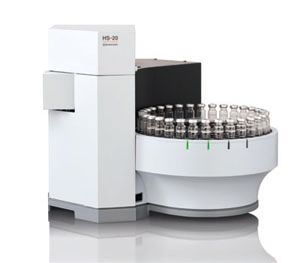HS-20 headspace sampler for GC and GC-MS
Environmental and pharmaceutical application, forensics, material and food production analyses ? Shimadzu?s new HS-20 headspace sampler serves GC and GC?MS applications particularly in testing and inspection organizations.

Environmental and pharmaceutical application, forensics, material and food production analyses – Shimadzu’s new HS-20 headspace sampler serves GC and GCMS applications particularly in testing and inspection organizations. The HS-20 covers accurate analysis of an even wider range of volatile compounds with boiling points ranging from low to high. The HS-20 heats liquid or solid samples sealed in a container to a specific tem-perature, and injects the volatile compounds diffusing into the gaseous phase into a GC or a GCMS.
Key features:
Minimum carryover for highly reliable analysis
In order to increase the reliability of data in continuous analysis of headspaces, carryover needs to be minimized, even in the flow lines. The special deactivated sample flow lines and unique flow line structure of the HS-20 reduces sample adsorption to achieve an extremely low carryover of 0.0001 % or less even for highly adsorptive acetic acid.
Efficient analysis of high boiling point compounds
The HS-20 oven can be set to a maximum of 300 °C to enable analysis of high boiling point compounds dif-ficult to detect with conventional headspace samplers. At just 30 cm, the HS-20 provides the shortest transfer line in its class between headspace and GC which enables efficient injections to the GC column to achieve high sensitivity analysis.
Increased sensitivity using the electronically cooled trap
The HS-20 trap model concentrates the headspace gas for high sensitivity analysis of volatile compounds gener-ated from the sample. Also, by cooling the trap unit to -20 °C low boiling point components can be concentrated efficiently in the trap. For example, components with a wide range of boiling points, such as odor components, can be analyzed with high sensitivity.
For more information please download the HS-20 Series brochure or visit www.shimadzu.eu
Polysorbate Quantification and Degradation Analysis via LC and Charged Aerosol Detection
April 9th 2025Scientists from ThermoFisher Scientific published a review article in the Journal of Chromatography A that provided an overview of HPLC analysis using charged aerosol detection can help with polysorbate quantification.
Analyzing Vitamin K1 Levels in Vegetables Eaten by Warfarin Patients Using HPLC UV–vis
April 9th 2025Research conducted by the Universitas Padjadjaran (Sumedang, Indonesia) focused on the measurement of vitamin K1 in various vegetables (specifically lettuce, cabbage, napa cabbage, and spinach) that were ingested by patients using warfarin. High performance liquid chromatography (HPLC) equipped with an ultraviolet detector set at 245 nm was used as the analytical technique.
Removing Double-Stranded RNA Impurities Using Chromatography
April 8th 2025Researchers from Agency for Science, Technology and Research in Singapore recently published a review article exploring how chromatography can be used to remove double-stranded RNA impurities during mRNA therapeutics production.





